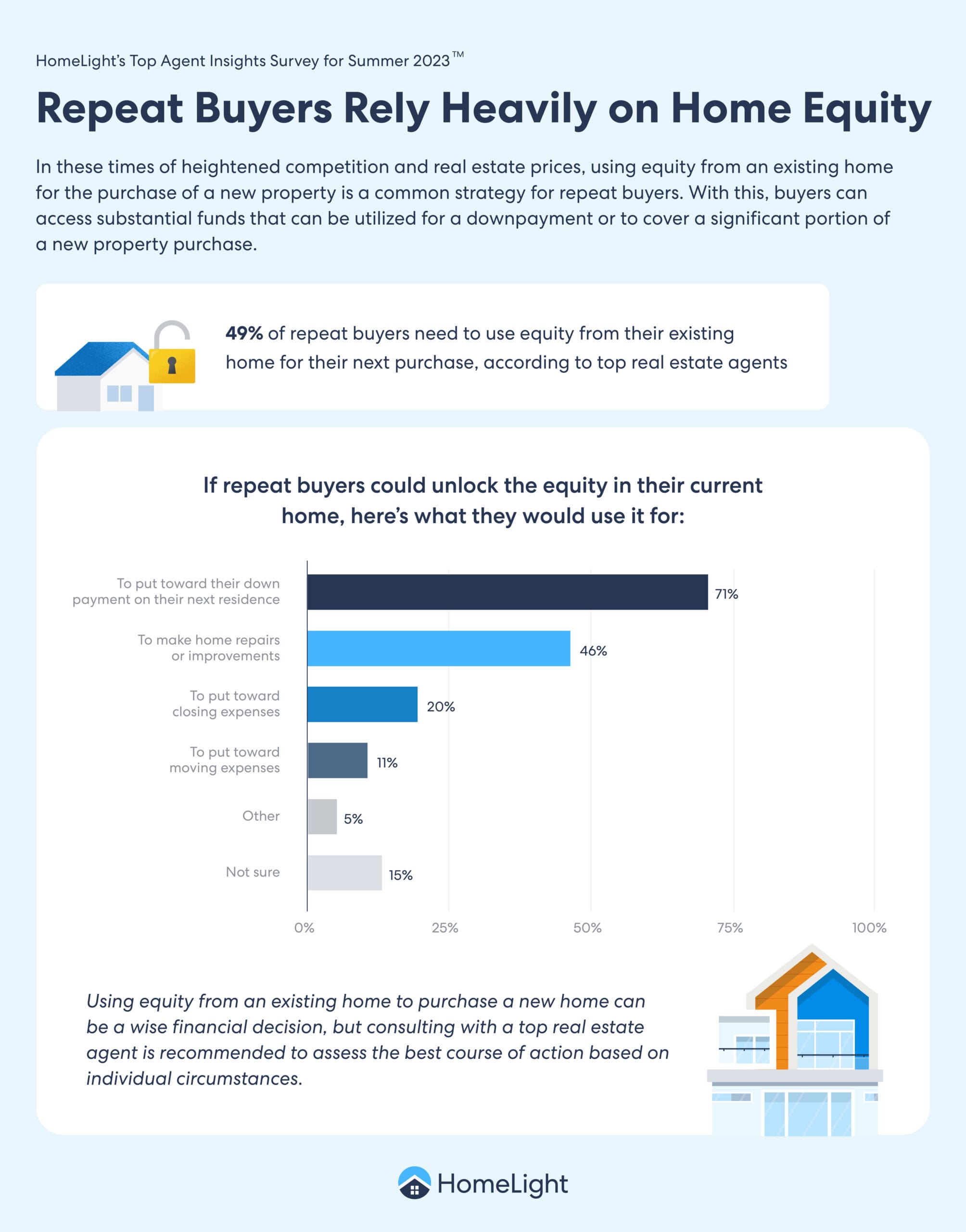Options to Unlock Your Home Equity When Finances Are Tight
- Published on
- 13 min read
-
 Adrian E. Hirsch, Contributing AuthorClose
Adrian E. Hirsch, Contributing AuthorClose Adrian E. Hirsch Contributing Author
Adrian E. Hirsch Contributing AuthorAdrian E. Hirsch is a South Louisiana interviewer, writer, editor, blogger and scriptwriter. She’s covered the region’s unique lifestyle, landmarks, architecture, art, antiques, food, music, pets and healthcare issues for the Los Angeles Times Syndicate, New Orleans, Memphis and Gambit magazines among others. Having bought, sold and built homes, she’s survived the whims of the market, contractors, kids, rescued cats and dogs—not to mention hurricanes, erosion and termite invasion. Her real estate reporting aims to help families find the right home and maximize the potential of that major investment.
-
 Richard Haddad, Executive EditorClose
Richard Haddad, Executive EditorClose Richard Haddad Executive Editor
Richard Haddad Executive EditorRichard Haddad is the executive editor of HomeLight.com. He works with an experienced content team that oversees the company’s blog featuring in-depth articles about the home buying and selling process, homeownership news, home care and design tips, and related real estate trends. Previously, he served as an editor and content producer for World Company, Gannett, and Western News & Info, where he also served as news director and director of internet operations.
DISCLAIMER: As a friendly reminder, this blog post is meant to be used for educational purposes only, not legal or tax advice. If you need assistance navigating the financial or tax implications of unlocking your home’s equity, HomeLight always encourages you to reach out to your own advisor.
With the days of stimulus packages and low mortgage interest rates in the rearview, Americans are steeling themselves for a future with the potential for economic uncertainty.
Increasing inflation on everything from gas to groceries and the reinstatement of student loans and other repayments (paused during the pandemic) are prompting some consumers to explore avenues to maximize their assets if times get tough.
Many homeowners find the greatest financial security lies right beneath their feet.
According to CoreLogic, U.S. homeowners with mortgages (roughly 62% of all properties) saw their equity increase by a total of $1.5 trillion since the first quarter of 2023, a gain of 9.6% over the previous year.
“With the record amount of equity built up in homes over the last couple of years,” says top-performing agent Joseph Lawson of the Cabell Childress Group in Richmond, Virginia, “a lot of people are exploring ways to tap into this access to capital.”
To help you examine your equity’s potential to enhance your financial situation, we’ve asked industry experts to explain the options. With that knowledge, you can be prepared to make the most out of the equity in your most valuable investment.
What is home equity?
“Home equity is the value of your home minus any debt on your home,” explains Lawson.
So, if you own a home that’s estimated to be worth $300,000, and owe $100,000 on your mortgage, then your equity is $200,000.
Since your home’s value changes with the market, your home might be worth more or less than the price you paid.
By using HomeLight’s free online Home Value Estimator, you can generate an up-to-date approximation of your home’s current value in less than two minutes.
While a mortgage is the most common debt, liens (legal claims against the property), back taxes, and outstanding balances owed to other creditors can also reduce your equity.
Also, “If you want to gain access to your equity by selling the home,” Lawson adds, “there are additional expenses related to the transaction of a sale — Realtor commissions, closing costs, etc., — that need to be deducted from your equity estimate.”
Can I get the equity out of my home without selling it?
You don’t have to sell your home to access your equity. If you meet eligibility requirements, many banks, credit unions, and other financial institutions have loans that allow homeowners to convert part of their equity to cash.
You can use that money for anything — debt consolidation, tuition, home renovation, a dream vacation, etc.
However, those funds aren’t exactly mad money because you have to pay the amount back with interest. And, removing the equity from your portfolio of assets does come with certain risks. So, it’s in your best interest to leverage your equity’s power to improve your financial future.
While some lenders have customized loans for home renovation or other projects, the most common types of equity loans are cash-out refinance and second mortgages, which include a home equity loan or a home equity line of credit (HELOC).

Since all these loans use your equity in the home as collateral, they usually offer significantly lower interest rates and better terms than personal loans, credit cards, and other unsecured debt.
What qualifications do I have to meet to access my home’s equity?
Before you weigh your options, it’s best to determine if you qualify.
Banks, credit unions, and other lenders each have their own criteria.
However, according to James Nedved, vice president and mortgage production manager at Regions Bank in Orlando, Florida, homeowners are likely to qualify for home equity loans, if they have:
- owned the home for a year or long enough to build sufficient equity
- made mortgage and other payments on time, and
- maintained a credit score of at least 620.
How does a cash-out refinance work?
In a cash-out refinance transaction, borrowers apply for a new loan, pay off their existing mortgage, and take the equity out of their home, which is subject to current interest rates. Their monthly payment on their new fixed-rate loan is based on the current interest rate and the new loan amount. Term lengths can vary.
So, if a husband and wife own a home that has equity totaling $300,000, owe $100,000 on their loan, and want to take out $100,000 — to consolidate student loan debt, pay off medical expenses and replace a leaky roof or even buy a vacation home — they might consider this mortgage loan.
The couple would apply for a new $200,000 loan, which would include the $100,000 they used to pay off their outstanding mortgage balance and another $100,000 for other uses. They can expect to pay 2% to 5% of the new loan amount as closing costs, or about $4,000 to $10,000. Borrowers can finance closing costs into their new mortgage by increasing the loan amount, or by subtracting the expense from the proceeds of their cash-out refinance.
No matter whether they spend the funds all at once or draw on them slowly over several years, their monthly payments encompass the entire $200,000 plus interest.
“You’re probably not seeing too many cash-out refinances right now,” says Lawson. “That’s because interest rates have gone up so significantly over the last six months.”
For example, it might not make sense for homeowners whose existing mortgage rate is 3.5% to refinance a large portion of the original loan plus additional funds at 6%.
Other options might be more attractive.
What are the differences between a cash-out refinance and secondary mortgages?
“A cash-out refinance is a mortgage transaction,” Nedved explains. “However, secondary mortgages — home equity loans and HELOCs — are consumer transactions, so they are governed by a different set of rules.”
Also, “because secondary mortgages are shorter-term loans than a cash-out mortgage,” Nedved says, “they are tied more to prime rate [similar to credit card rates, which are usually prime plus a percentage] than a mortgage is.”
Nedved says, “Many times, cash-out transactions are at a higher rate because you are taking equity out of your home.”
By contrast, second mortgages leave the first mortgage intact, which could save the homeowner money in the long run. Particularly if the homeowners bought the home in the last two years, “That pricing is a lot better than we can get today,” says Nedved.
Furthermore, Nedved says many banking institutions usually absorb the closing costs of home equity loans and HELOCs up to $250,000. Often, homeowners are only responsible for paying the cost of an appraisal.
However, secondary mortgages don’t work for everyone since every situation is different.
As a primary mortgage loan, the cash-out refinance tends to be repaid over a longer time period, so the amount of each monthly payment may be smaller than those of second mortgage options. With the ongoing inflation, a smaller monthly outlay may be easier on the family budget.
How does a home equity loan work?
Because interest rates continue to fluctuate unpredictably, homeowners with low-interest mortgages may find a home equity loan to be more cost effective.
After finishing all their calculations, the homeowners above realize a cash-out refinance is going to raise their monthly payments ridiculously. As determined as ever to achieve their dream of paying off debt (or owning a vacation home), the homeowners investigate the possibility of a home equity loan.
To retain the 3% interest rate on their first mortgage, the couple applies for a second mortgage for the additional $100,000. If that application is approved, they now have two loans.
The balance on the first mortgage is $100,000 at 3% interest. The new loan is for another $100,000 at 6% interest (or whatever is the current rate) — which is still more economical than the cash-out refi with $200,000 at 6% interest.
However, a second mortgage usually carries a higher interest rate than first mortgage rates nationwide. That’s because, in the case of selling a house in foreclosure, the first mortgage lender will need to be paid in full from the proceeds of the home sale before the second mortgage lender can be paid.
Because it’s an installment loan, the couple receives all the funds upfront and pays back principal and interest on a pre-set schedule, usually over five to 15 years.
To help you leverage your home equity to purchase a new home, consider using HomeLight’s Buy Before You Sell program. We’ll evaluate your existing property using a proprietary algorithm to determine how much of your home equity you can unlock to put toward the down payment of your new home, moving expenses, closing expenses, or property repairs — allowing you to make a contingency-free offer on a new home.
What are the advantages of a Home Equity Line of Credit (HELOC)?
Because they’re smart consumers who like to weigh all the options and value financial flexibility, the homeowners decide to explore whether a HELOC is the best fit to utilize their equity and acquire additional funding.
Once they set up a $100,000 HELOC, the couple can withdraw some or all of the funds at one time or in various increments — in the same way they would use a credit card — over a five- to 10-year period. During that draw-down phase, they only pay interest on the amount they withdraw.
So, if they decide to pay off the medical expenses first to prevent going to collections, before they tackle the student debt or roof, their monthly balance reflects only the variable-rate interest on the amount paid to medical creditors. (It should be noted that while most HELOCs have variable interest rates, not all do.)
They do not repay principal and interest immediately. “And, you don’t pay anything on it, unless you draw from it,” Lawson explains.
However, when the draw-down period ends — even if they haven’t withdrawn the entire amount — they are ineligible to borrow any more money.
Then, during the repayment phase, the borrowers typically have 10 to 20 years to repay any outstanding balance.
Because the interest-only payments made during the draw-down can be pretty modest, some homeowners suffer from sticker shock in the repayment phase. So, borrowers need to plan for those higher payments and the potential impact on the family budget.
Even if they don’t need cash right away, many homeowners proactively set up a HELOC as a rainy-day emergency fund.
“If you have a family emergency, want to renovate your home, need to make a large purchase, or access to a large amount of money quickly,” Lawson says, “having that vehicle set up gives you the availability of that capital.”
How do I know which home equity option is best for me?
“I have those conversations on a regular basis, and there isn’t a one-size-fits-all solution,” Nedved says. “We move towards the least costly option first; and, if that doesn’t work, we aim for the best solution long term.”
For example, if the homeowners just want to add a pool, a HELOC might be the best option.
If the homeowners’ first mortgage is at an amazingly low rate and they value the predictability of an installment plan, a traditional home equity loan might be the right choice.
If it’s a debt situation in which the family needs to have the lowest payment possible because the homeowner is on a fixed income situation, a full cash-out refinance might be more beneficial.
However, “The best option depends on a whole host of parameters that are specific to the client’s situation and what the total family budget looks like,” Nedved says. “That’s why it’s important to work with a trusted mortgage or consumer lending advisor.”
What are the pros of pursuing a home equity loan?
“Most people don’t have access to thousands of dollars in cash,” says Lawson. “So, the primary advantage of using your home equity is access to a large amount of capital in a short amount of time.”
Other advantages of taking equity out of your home can include:
- Get a lower interest rate than personal loans or credit cards
- Fewer fees than some loans
- More flexibility in repayment options
- Fewer borrowing restrictions
What are the cons of cashing out home equity?
However, seeking a second mortgage or cash-out refinance is not without risk. The less equity you have in your property, the higher your overall debt.
“So, if you were to lose your job, if a recession hits, if you come into harder financial times and you’re more highly leveraged on your property,” Lawson explains, “that’s a more risky situation to be in — with higher monthly payments and more uncertainty with your employment.”
For some homeowners, that scenario also brings back bad memories from the 2008 housing crisis. When home values plummeted, some homeowners realized they had maxed out their loan equity and had no financial reserves to draw on in an emergency situation.
“That doesn’t appear to be the case today,” says Nedved, who has been in the mortgage business for more than 27 years, “But, that’s not an absolute. There’s always that risk.”
Other drawbacks of taking equity out of your home can include:
- Use of your home as collateral
- Potential for foreclosure and homelessness, if payments aren’t made
- Risk of declining home values
As a Realtor with over 15 years of experience, Lawson offers another perspective. “It’s kind of a pro and a con built into one,” he admits.
“People are really concerned about the interest rates increasing so dramatically,” he begins. “But even rates at 5.5% and 6% are still historically really low. So, even at those rates, home equity loans are still a really great way to tap into a lot of capital.”
Who can I rely on to help make this decision?
Whether to access the equity in your home is not a decision to be made lightly. Fortunately, it doesn’t have to be made alone.
Both Lawson and Nedved advise collecting the appropriate documents, conducting your research, consulting with your family co-signers, and seeking out the expertise of some or all of these professionals, including a/an:
- Consumer or mortgage loan officer: to understand the details of financial products, what the current interest rates are, and projections of your monthly payment.
- Financial planner: to understand how cashing out your equity impacts your financial future and investment strategy.
- Accountant: to investigate whether there are tax advantages to choosing a certain loan option.
What should homeowners have with them before seeking the advice of a professional?
Before visiting the mortgage or consumer loan professional, it’s important to present/collect financial documentation, including:
- Last two years of W2s (or other appropriate evidence of income)
- Last three pay stubs
- Current mortgage statement
Some lenders may require a more extensive list of documentation, but these three are a good place to start.
Nedved says The Big Three (above) and your credit score provide lenders with an accurate estimation of what you currently owe and how much additional debt you can afford.
Another essential element of a strong loan application is an honest conversation at home between adults applying for a loan together.
“If they can agree on where they are now and what their financial goals are, the mortgage lender can do a better job of navigating them towards their goal.”
No need to wait for dire economic straits
There’s no need to wait until you’re in dire economic straits to investigate the potential of using your equity to improve your financial future.
By using HomeLight’s Home Value Estimator, you can quickly and easily approximate the value of your home and then deduct what you owe to determine your ballpark equity.
Paying off high-interest loans, home renovations and repairs, or even purchasing another property can be a good investment of equity.
You may find having a HELOC at the ready gives you peace of mind, keeping your current mortgage and adding the home equity loan achieves your objectives most cost-efficiently, or the longer term of a cash-out refinance works best for your family budget.
Ultimately, you may even find that leaving your equity undisturbed is really the ideal option.
Header Image Source: (elCarito / Unsplash)






